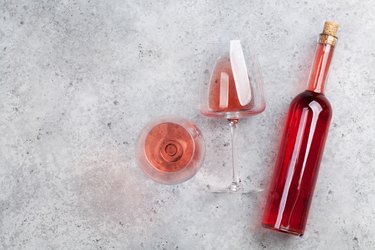
When you pour a glass of rose wine, rose nutrition isn't the first thing on your mind. You'd also probably rather forget about the rose wine calories. However, you may still be able to enjoy an occasional glass while meeting your weight management goal.
Tip
Rose wine contains relatively few calories, with a 3.5-ounce serving containing only 83 calories. Rose is also lower on the carbohydrate scale, with only 3.8 grams of carbs for the same-size glass, says the USDA.
Video of the Day
Finding the Rose Wine Calories
Red wine and white wine continue to have their devotees, but rose wine is also a popular choice. This relatively inexpensive wine can feature a range of rose-tinted hues and a taste that ranges from sweet to dry.
Video of the Day
The number of calories in a glass of rose might make this variety a good choice. The USDA states that a 100-gram (or 3.5-fluid ounce) glass of rose wine contains 83 calories. A bottle of rose wine contains 532 calories, says the Alcoholism Guide.
In addition to encouraging numbers of calories in rose, nutrition may also be important. Note that this pinkish-toned wine only contains 5 milligrams of sodium and has zero fat.
The Stony Brook Bariatric and Metabolic Weight Loss Center emphasizes that you shouldn't consume more than one alcoholic drink daily, if you're a woman. If you're a man, two alcoholic drinks per day is the recommended amount.
Read more: How Bad Is Alcohol for Weight Loss?
Drinking and Weight Reduction
For comparison purposes, the U.S. National Library of Medicine provides calorie counts for several types of alcoholic beverages. Light beer contains only 100 calories for a standard 12-ounce glass, while regular beer packs a heftier 150 calories for the same serving. Spirits also contain, on average, around 100 calories per serving.
Wine is on the low end of the calorie ladder too, with about 100 calories for an average 5-ounce glass. With fewer calories in a glass of rose, this popular wine may be a good choice.
To really stack the deck in your favor, limit your daily carbohydrate intake. First, find a low-carb wine that you enjoy. As a guideline, sweeter or dessert wines will have a higher carb count. In contrast, dry wines will rank lower on the carbohydrate scale, says the University of Massachusetts Medical School. To further reduce your carb count, consume low-carb foods such as healthy proteins and vegetables.
Keep an eye on how much wine you're actually drinking. It's easy to misjudge the amount you pour, and those extra ounces can add up to a significant number of calories to be burned.
Read more: Does Drinking Alcohol Slow Your Metabolism?
Pausing Your Alcohol Consumption
If you've decided to temporarily limit your wine consumption in order to cut calories, the Cleveland Clinic suggests you try several different approaches. Consider removing alcohol from your eating plan for a few weeks,and then recheck your weight. If that's too drastic, decrease your serving size to 4 ounces and only consume one serving daily.
In some cases, you may want to avoid alcohol entirely, states the Mayo Clinic. If you have been affected by heart failure or other heart issues, or have pancreatic or liver disease, it may be best to remove alcohol from your diet. If you're currently pregnant or actively trying to become pregnant, drinking alcohol isn't recommended. Checking with your doctor before taking any health-related action is also advisable.
Read more: 5 Hidden Health Benefits of Alcohol
- USDA: "Alcoholic Beverages, Wine, Rose"
- Stony Brook University Renaissance School of Medicine: "FAQs About Alcohol Consumption and Weight Gain"
- U.S. National Library of Medicine: "Weight Loss and Alcohol"
- Cleveland Clinic: "Weight Loss: What’s Wine Doing to Your Waistline?"
- Mayo Clinic: "Alcohol: Weighing Risks and Potential Benefits"
- The Alcoholism Guide: "Alcohol Calorie Chart"
- University of Massachusetts Medical School: "Alcohol and Diabetes"